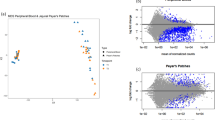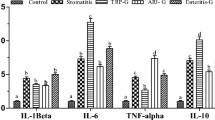Abstract
The callitrichids are non-human primates that feed on insects and plant matter in nature, but in captivity, they are fed mostly an artificial diet containing amounts of gluten, in their toxic forms in items such as wheat, barley and rye. The aim of this research was to estimate the blood β-defensin and Toll like receptor 5 (TLR5) gene expressions and to analyze the stool consistency (firm, soft, diarrheic) in Leontocebus fuscicollis raised in captivity. Blood samples of animals under gluten-free and gluten diets were collected and their fecal output quality was periodically monitored and classified during the course of the study. Gene expression was evaluated using real-time PCR. The stool consistencies of individuals fed a gluten diet were most frequently soft or diarrheic, while it was mostly normal in individuals fed a gluten-free diet. β-Defensin expression increased in individuals fed a gluten diet, but decreased after 15 days. Expression normalized between 30 and 45 days on a gluten-free diet. However, expression of the TLR5 gene did not change under a gluten diet. A gluten diet affects stool quality, and brings about an immediate increase in blood β-defensin expression in the beginning but decreases after 15 days.




Similar content being viewed by others

Abbreviations
- GD:
-
Gluten diet
- GFD:
-
Gluten free diet
- RT-PCR:
-
Real time-polymerase chain reaction
- TLR :
-
Toll like receptor
- GAPDH :
-
Glyceraldehyde 3-phosphate dehydrogenase
References
Vilela AA, Del-Claro K (2011) Feeding behavior of the black-tufted-ear marmoset (Callithrix penicillata) (Primate, Callitrichidae) in a tropical Cerrado savanna. Sociobiology 58:1–6
Ravetta AL, Calouro AM, Messias MR (2015) Avaliação do Risco de Extinção de Saguinus weddelli weddelli (Deville, 1849) no Brasil. Processo de avaliação do risco de extinção da fauna brasileira. ICMBio, Brasília
Kuehnel F, Mietsch M, Buettner T, Vervuert I, Ababneh R, Einspanier A (2013) The influence of gluten on clinical and immunological status of common marmosets (Callithrix jacchus). Am J Primatol 42:300–3009. https://doi.org/10.1111/jmp.12055
Junker Y, Zeissig S, Kim S-J, Barisani D, Wieser H, Leffler DA, Zevallos V, Libermann TA, Dillon S, Freitag TL, Kelly CP, Schuppan D (2012) Wheat amylase trypsin inhibitors drive intestinal inflammation via activation of toll-like receptor 4. J Exp Med 209:2395–2408. https://doi.org/10.1084/jem.20102660
Elli L, Branchi F, Tomba C, Villalta D, Norsa L, Ferretti F, Roncoroni L, Bardella MT (2015) Diagnosis of gluten related disorders: celiac disease, wheat allergy and non-celiac gluten sensitivity. World J Gastroenterol 21:7110–7119. https://doi.org/10.3748/wjg.v21.i23.7110
Bethune MT, Borda JT, Ribka E, Liu MX, Phillippi-Falkenstein K, Jandacek RJ, Doxiadis GG, Gray GM, Khosla C, Sestak K (2008) A nonhuman primate model for gluten sensitivity. PLoS ONE 3:e1614. https://doi.org/10.1371/journal.pone.0001614
Kryszak D, Mcgill H, Leland M, Fasano A (2006) Novel nonhuman primate model of celiac disease. J Pediatr Gastroenterol Nutr 43:e71–e72
Gore MA, Brandes F, Kaup FJ, Lenzner R, Mothes T, Osman AA (2001) Callitrichid nutrition and food sensitivity. Hum Immunol 30:179–184. https://doi.org/10.1111/j.1600-0684.2001.tb00007.x
Alvisi P, De Fazio L, Valerii MC, Cavazza E, Salerno A, Lacorte D, Dinelli G, Spisni E (2017) Responses of blood mononucleated cells and clinical outcome of non-celiac gluten sensitive pediatric patients to various cereal sources: a pilot study. Int J Food Sci Nutr 19:1–8. https://doi.org/10.1080/09637486.2017.1315058
Sjöberg V, Sandström O, Hedberg M, Hammarström S, Hernell O, Hammarström M-L (2013) Intestinal T-cell responses in celiac disease—impact of celiac disease associated bacteria. PLoS ONE 8(1):e53414. https://doi.org/10.1371/journal.pone.0053414
Sampaio R, Röhe F, Pinho G, Silva-Júnior JS, Farias IP, Rylands AB (2015) Re-description and Assessment of the Taxonomic Status of Saguinus fuscicollis cruzlimai Hershkovitz, 1966 (Primates, Callitrichinae). Primates 56(2):131–144. https://doi.org/10.1007/s10329-015-0458-2
Kanthaswamy S, Elfenbein HA, Ardeshir A, Ng J, Hyde D, Smith DG, Lerche N (2014) Familial aggregation of chronic diarrhea disease (CDD) in rhesus macaques (Macaca mulatta). Am J Primatol 76:262–270. https://doi.org/10.1002/ajp.22230
Wagner JD, Erome CP, Adams MR (1988) Gluten-sensitive enteropathy in a cynomolgus monkey. Lab Anim Sci 38:592–594
Brady AG, Carville AAL (2012) Digestive system diseases of nonhuman primates. In: Abee CR, Mansfield K, Tardif S, Morris T (eds) Nonhuman primates in biomedical research, V 2: Diseases. Elsevier, San Diego, pp 589–629. https://doi.org/10.1016/b978-0-12-381366-4.00012-2
Abadie V, Sollid LM, Barreiro LB, Jabri B (2011) Integration of genetic and immunological insights into a model of celiac disease pathogenesis. Annu Rev Immunol 29:493–525. https://doi.org/10.1146/annurev-immunol-040210-092915
Christophersen A, Ráki M, Bergseng E, Lundin KE, Jahnsen J, Sollid LM, Qiao SW (2014) Tetramer-visualized gluten-specific CD4+ T cells in blood as a potential diagnostic marker for coeliac disease without oral gluten challenge. U Eur Gastroenterol J. 2:268–278. https://doi.org/10.1177/2050640614540154%5d
Anderson RP, Degano P, Godkin AJ, Jewell DP, Hill AV (2000) In vivo antigen challenge in celiac disease identifies a single transglutaminase-modified peptide as the dominant A-gliadin T-cell epitope. Nat Med 6:337–342. https://doi.org/10.1038/73200
Power ML, Toddes B, Koutsos L (2012) Nutrient requirements and dietary husbandry principles for captive nonhuman primates. In: Abee CR, Mansfield K, Tardif S, Morris T (eds) Nonhuman primates in biomedical research: biology and management, 2nd edn. Academic Press, Boston, pp 269–286. https://doi.org/10.1016/b978-0-12-381365-7.00010-8
Taha AS, Faccenda E, Angerson WJ, Balsitis M, Kelly RW (2005) Natural antibiotic expression in celiac disease-correlation with villous atrophy and response to a gluten-free diet. Dig Dis Sci 50:791–795. https://doi.org/10.1007/s10620-005-2575-z
Intrieri M, Rinaldi A, Scudiero O, Autiero G, Castaldo G, Nardone G (2010) Low expression of human beta-defensin1 in duodenum of celiac patients is partially restored by a gluten-free diet. Clin Chem Lab Med 48:489–492. https://doi.org/10.1515/CCLM.2010.098
Fernandez-Jimenez N, Castellanos-Rubio A, Plaza-Izurieta L, Gutierrez G, Castaño L, Vitoria JC, Bilbao JR (2010) Analysis of beta-defensin and Toll-like receptor gene copy number variation in celiac disease. Hum Immunol 71:833–836. https://doi.org/10.1016/j.humimm.2010.05.012
Kalliomäki M, Satokari R, Lähteenoja H, Vähämiko S, Grönlund J, Routi T, Salminen S (2012) Expression of microbiota, Toll-like receptors, and their regulators in the small intestinal mucosa in celiac disease. J Pediatr Gastroenterol Nutr 54:727–732. https://doi.org/10.1097/MPG.0b013e318241cfa8
Acknowledgements
Thanks go to the National Primate Center for every support required for the animals and workers. We also thank the National Council of Technological and Scientific Development (CNPq) for funding this research.
Author information
Authors and Affiliations
Corresponding author
Ethics declarations
Conflict of interest
The authors declare no potential conflict of interest with respect to the research, authorship, and/or publication of this article.
Ethical approval
All procedures that use animals were in accordance with the norms established by the National Council of Control of Animal Experimentation (CONCEA) of Brazil. All experimental procedures were registered on the Biodiversity Authorization and Information System of the Chico Mendes Institute of Biodiversity (SISBIO/ICMBIO, protocol number 47969-1) and was approved by the Ethics Committee of Animal Use at the Evandro Chagas Institute (CEUA/IEC, Protocol Number 17/2015).
Additional information
Publisher's Note
Springer Nature remains neutral with regard to jurisdictional claims in published maps and institutional affiliations.
Rights and permissions
About this article
Cite this article
Almeida, T.T.G., Monteiro, M.V.B., Guimarães, R.C. et al. Effect of gluten diet on blood innate immune gene expressions and stool consistency in Spix’s Saddleback Tamarin (Leontocebus fuscicollis) raised in captivity. Mol Biol Rep 46, 3617–3623 (2019). https://doi.org/10.1007/s11033-018-04576-8
Received:
Accepted:
Published:
Issue Date:
DOI: https://doi.org/10.1007/s11033-018-04576-8



